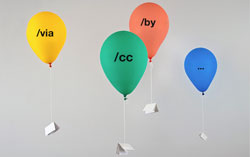New syntax in Twi: Slashtagi
 Fortunately, on Twitter, the message has a 140 character limit. And I want to say so much ... Every character in the account! We have to reduce thoughts, remove spaces, use urls, etc. Therefore, Twitter users have begun to use syntax, which not only reduces the message, but also carries with it a certain semantic meaning.
Fortunately, on Twitter, the message has a 140 character limit. And I want to say so much ... Every character in the account! We have to reduce thoughts, remove spaces, use urls, etc. Therefore, Twitter users have begun to use syntax, which not only reduces the message, but also carries with it a certain semantic meaning.Interestingly, the syntax is invented and actively used by Twitter users themselves, and only then the creators of the service embed them into their interface. Examples of already working characters are retweet "RT" and hashtags - "#". Recently, in the English-speaking twitter community, the so-called slash tags are increasingly being used, and I wanted to tell about them.
The idea of using slash tags is similar to the idea of hashtags. But unlike the hashtags, which are used to designate the main target word or phrase in the message (for further search), slash tags are used to designate other people (tviplov) in this message. And if hashtags are denoted by a single “#” symbol and the target word behind this symbol (eg #followfriday #sexymonday), then slash tags are denoted by different words (“pointers”) that follow the “/” symbol (slash).
')
Slashtags are respectively a collection of phrases that follow a slash.
Using slash tags:
Unlike hashtags, each slash tag does not have to start with a slash. For example:
Right:
- Mom washes the frame / via mama
- Mom washes the frame / via papa by mama cc son @daughter
Wrong:
- Mummy washes rama / via papa / by mama / cc son / cc @daughter
Let us turn to the list of slash tags with examples, so it will be clearer:
/ via
Often used tag in Russian segment Twi. This slash tag is used by analogy with RT, i.e. then when we want to quote someone. We save only 1 character, but we have a beautifully designed message.
Previously wrote:
- RT mama : “Mom washes the frame”
- Mom washes the frame (via mama )
Now we write:
- Mom washes the frame / via mama
/ by
The slashtag / by is identical to the tags / via and RT, but slightly different from them. / by denotes the author of the original message. This is especially useful in a long chain of retweets.
Previously wrote:
- Here is the mother clever RT son : RT papa : RT mama : "Mom washes the frame"
Now we write
- Mom washes the frame / via son by mama
/ ss
This tag is used by analogy with e-mail - in order to draw someone’s attention to this tweet.
Previously wrote:
- @daughter and son notice that RT mama : “Mom washes the frame”
Now we write
- Mom washes the frame / via mama cc @daughter son
Also use the same / for slash tag. Example:
- Mom washes the frame / via mama for @daughter son
/ thx
If you want to thank tvipla for help, for the idea, but you do not have enough space in the message, you can use the slash / thx
Previously wrote:
- Thank you, daughter RT @daughter: “Mom, use Mr. Muscle’s frame for washing”
Now we write:
- I use Mr. Muscle in the sink of the frame / thx @daughter
Also in similar cases, when a certain tvipl gives useful advice, you can use the slash / hat tip or / ht
These are some of the slash tags that are more actively used by twiple and even supported by some applications, for example Tweetie 2 on the IPhone.
It may seem that the use of slash tags slightly kills the “humanity” in communication, the message becomes dry, similar to the code, but it seems to me that this style may like some tviplam. For example, on my Twitter account ( @ukrtaxist ), I am starting to get used to using slash tags and urge you to use slash tags in further communication on Twitter.
Upd: A few words about the small difference between RT and / via. Retvit "RT" - this is a clean quote, perhaps with their comments. / via - is used more often with a free retelling of the original message.
For example:
- RT mama : “Mom washed the frame”
and
- Mom washed the frame and now it is, frame, cleaner than all! / via mama
Upd2: Excuse me , did not initially indicate the sources of information (engl):
- article about slash tags - ow.ly/HU26
- microsyntax encyclopedia on Twitter - ow.ly/PqFw
Source: https://habr.com/ru/post/79234/
All Articles